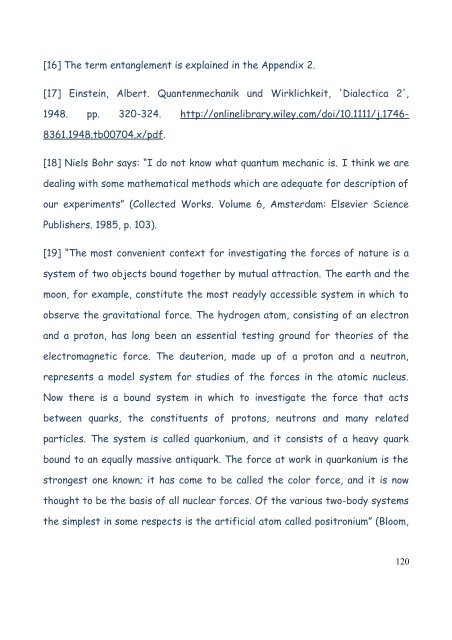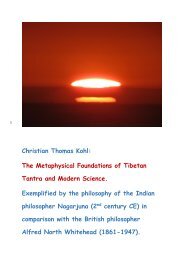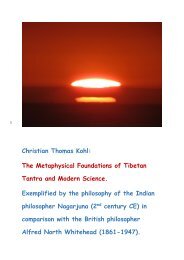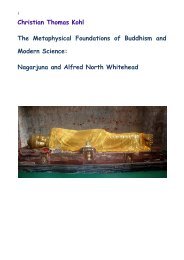Christian Thomas Kohl The Metaphysical Foundations of Buddhism and Modern Science
Christian Thomas Kohl The Metaphysical Foundations of Buddhism and Modern Science
Christian Thomas Kohl The Metaphysical Foundations of Buddhism and Modern Science
You also want an ePaper? Increase the reach of your titles
YUMPU automatically turns print PDFs into web optimized ePapers that Google loves.
[16] <strong>The</strong> term entanglement is explained in the Appendix 2.<br />
[17] Einstein, Albert. Quantenmechanik und Wirklichkeit, 'Dialectica 2',<br />
1948. pp. 320-324. http://onlinelibrary.wiley.com/doi/10.1111/j.1746-<br />
8361.1948.tb00704.x/pdf.<br />
[18] Niels Bohr says: “I do not know what quantum mechanic is. I think we are<br />
dealing with some mathematical methods which are adequate for description <strong>of</strong><br />
our experiments” (Collected Works. Volume 6, Amsterdam: Elsevier <strong>Science</strong><br />
Publishers. 1985, p. 103).<br />
[19] “<strong>The</strong> most convenient context for investigating the forces <strong>of</strong> nature is a<br />
system <strong>of</strong> two objects bound together by mutual attraction. <strong>The</strong> earth <strong>and</strong> the<br />
moon, for example, constitute the most readyly accessible system in which to<br />
observe the gravitational force. <strong>The</strong> hydrogen atom, consisting <strong>of</strong> an electron<br />
<strong>and</strong> a proton, has long been an essential testing ground for theories <strong>of</strong> the<br />
electromagnetic force. <strong>The</strong> deuterion, made up <strong>of</strong> a proton <strong>and</strong> a neutron,<br />
represents a model system for studies <strong>of</strong> the forces in the atomic nucleus.<br />
Now there is a bound system in which to investigate the force that acts<br />
between quarks, the constituents <strong>of</strong> protons, neutrons <strong>and</strong> many related<br />
particles. <strong>The</strong> system is called quarkonium, <strong>and</strong> it consists <strong>of</strong> a heavy quark<br />
bound to an equally massive antiquark. <strong>The</strong> force at work in quarkonium is the<br />
strongest one known; it has come to be called the color force, <strong>and</strong> it is now<br />
thought to be the basis <strong>of</strong> all nuclear forces. Of the various two-body systems<br />
the simplest in some respects is the artificial atom called positronium” (Bloom,<br />
120


















